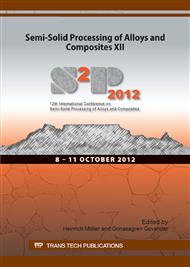p.341
p.347
p.353
p.359
p.365
p.373
p.379
p.386
p.392
High Temperature Flow Behaviour of Semi-Solid Steel Alloys
Abstract:
Semi-solid processing is an attractive and an effective near-net-shape forming process to produce components with complex geometry and in fewer forming steps. Its key is the spheroidal solid particles suspended in a liquid matrix which in turn eventuate in a complex thixotropic behaviour of semi-solids. However, the consequences of such behaviour on the flow during semi- solid forming processes is still neither completely characterized and nor fully understood, especially for high melting point alloys like steels. Many attempts have been made for understanding the time- dependent flow behaviour of semisolid materials which is essential for the simulation of semi-solid processes. During processing, the structure of a semi-solid material changes with the processing history due to agglomeration and dissagglomeration of particles or particle–particle interactions. This kind of processing condition can be experimented using rotary rheometers. In the case of steel alloys, conventional rheometers cannot be directly used because of their high temperature processing conditions. For this purpose, a self-developed rotary rheometer has been employed to study the rheology of steels up to 1500 oC. Steel samples are melted in an Alumina cup and sheared with an Alumina rod in a resistance furnace under isothermal condition and also under argon controlled atmosphere. The torque and rotary speed signals are used to calculate the viscosity and shear rate data. For rheology investigations, shear rate jump experiments and rest experiments have been carried out using the rheometer for different steel alloys. The flow of SSM is modelled using the Herschel–Bulkley fluid model. The viscosity and the power-law index are assumed to be functions of the solid volume fraction and a structural parameter that changes with the processing history. The evolution of the structural parameter is described by a first-order kinetic differential equation. The model is in a good agreement with the experimental results which can then be used for simulation purposes.
Info:
Periodical:
Pages:
365-369
Citation:
Online since:
October 2012
Authors:
Keywords:
Price:
Сopyright:
© 2013 Trans Tech Publications Ltd. All Rights Reserved
Share:
Citation:


